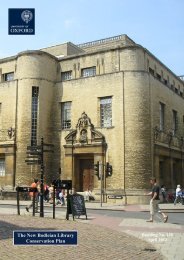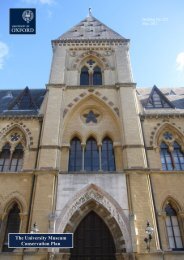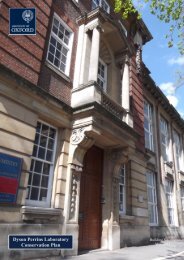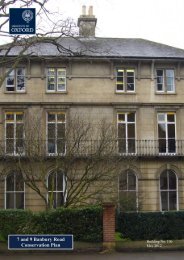The Sheldonian Theatre Conservation Plan - Central Administration ...
The Sheldonian Theatre Conservation Plan - Central Administration ...
The Sheldonian Theatre Conservation Plan - Central Administration ...
Create successful ePaper yourself
Turn your PDF publications into a flip-book with our unique Google optimized e-Paper software.
3.3 Historical Significance<br />
<strong>The</strong> long history of the <strong>Sheldonian</strong> <strong>The</strong>atre is summarised above (Section 2.2 and<br />
Section 2.3) and is clearly a major component of its significance as a heritage asset.<br />
As the meeting-place of the Congregation, from its construction the history of the<br />
<strong>Sheldonian</strong> is synonymous with the history of the University.<br />
<strong>The</strong> list of distinguished alumni who matriculated and graduated within this building<br />
is too long to quote, but includes prominent historical and literary figures such as: Sir<br />
Robert Peel the Younger; William Ewart Gladstone; Edward VII; Clement Attlee;<br />
Tony Benn; T.E. Lawrence; Philip Larkin; Iris Murdoch; Mary Renault; and J.R.R.<br />
Tolkien; as well as countless prominent academics. <strong>The</strong> numerous notable historical<br />
figures that have had even this passing acquaintance with the <strong>Sheldonian</strong> make it one<br />
of the nation’s foremost historical buildings.<br />
<strong>The</strong> <strong>Sheldonian</strong> is also significant as the location of the premier of Handel’s oratorio<br />
Athalia on the 10 th July 1733, which was conducted in person by the composer<br />
himself. This marks its significance in the history of music, and it continues to be an<br />
important location for live performances to this day.<br />
<strong>The</strong> history of the <strong>Sheldonian</strong> is remarkably well recorded throughout its lifespan,<br />
beginning with the logs recording the payment of the works responsible for its initial<br />
construction. <strong>The</strong> Bodleian Library contains a wealth of information on the<br />
<strong>Sheldonian</strong>, allowing one to trace the construction history of the building to an<br />
astonishing degree. This makes it a significant resource for the study of historical<br />
building methods.<br />
3.4 Archaeological Significance<br />
<strong>The</strong> <strong>Sheldonian</strong> is built on the location of several houses dating from the first half of<br />
the Seventeenth Century or earlier. <strong>The</strong>se were demolished for its construction but,<br />
whilst the building does have cellars, there is likely to be some extant subterranean<br />
archaeological material relating to them; moreover, the areas beneath and around the<br />
<strong>Sheldonian</strong> no doubt hold archaeological material related to the construction of the<br />
<strong>The</strong>atre itself. During excavations in 1962-63, the city ditch, infilled in the 17 th<br />
century, was found to run through and to the northwest of the <strong>Sheldonian</strong>.<br />
Whilst the paved area around the <strong>Sheldonian</strong> has been reconfigured on numerous<br />
occasions, the area has a continuous history of occupation since at least the Eleventh<br />
Century, and the probable depth of the relevant stratigraphic layers would suggest that<br />
it is likely that significant material may be extant.<br />
3.5 Architectural Significance<br />
3.5.1 Wren<br />
<strong>The</strong> <strong>Sheldonian</strong> <strong>The</strong>atre was the first major commission of Sir Christopher Wren<br />
(1632-1723), although it was completed after his second, the design for the chapel of<br />
Pembroke College, Cambridge, finished in 1663. <strong>The</strong> <strong>Sheldonian</strong> <strong>The</strong>atre employs a<br />
combination of classical design (based loosely upon the first-century <strong>The</strong>atre of<br />
<strong>Sheldonian</strong> <strong>The</strong>atre,<br />
<strong>Conservation</strong> <strong>Plan</strong>, May 2012<br />
15

















